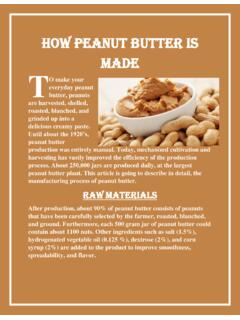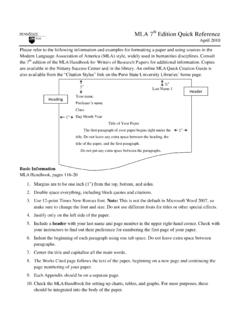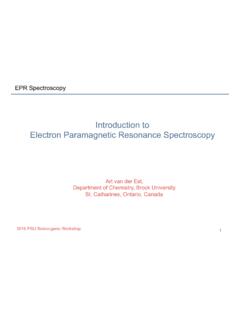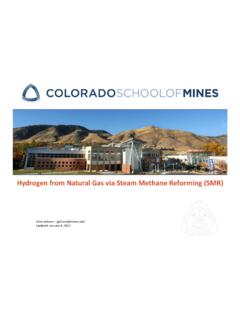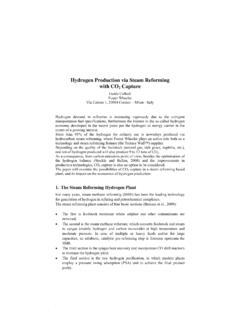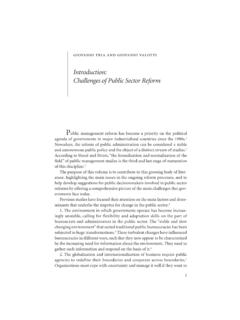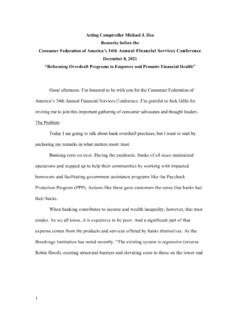Transcription of The Production of Hydrogen Gas: Steam Methane Reforming
1 The Production of Hydrogen Gas: Steam Methane Reforming Kevin Bakey ENGL 202C Process Description March 23, 2015 - 1 - Audience and Scope This document is intended to familiarize college students or professionals with the Steam Methane Reforming Process. The reader must have a basic understanding of chemistry and engineering terminology. College students who are interested in entering the industrial gas industry may find this knowledge useful for a class, during an interview, or when deciding what specific field they want to enter. A professional entering into an industrial gas job would want to familiarize themselves with this process as it is the most prominent means of Hydrogen Production in modern industry.
2 This document includes an introduction to the Steam Methane Reforming process, along with a step by step description with graphics explaining how the process works and the reactions involved. Introduction to Steam Methane Reforming Steam Methane Reforming (SMR) is a chemical process used in the gas manufacturing industry to produce Hydrogen on a large scale. This process contains two chemical reactions which ultimately convert water and Methane (usually in the form of natural gas) into pure Hydrogen and carbon dioxide. The Hydrogen gas is then further purified to a quality specified by the customer. SMR is the most common and economical way to make Hydrogen gas, which is used for electricity Production , refining oil, countless chemical processes, and many more industrial applications.
3 Figure 1: Steam Methane Reforming Plant - Linde Engineering - 2 - Steam Methane Reforming Process First, water must be heated in a furnace to produce Steam . The superheated Steam is mixed with natural gas in the Reforming reaction, producing Hydrogen gas and carbon monoxide. Carbon monoxide from the Reforming reaction interacts with water again to produce more Hydrogen and carbon dioxide. Filters are used to purify the Hydrogen gas, which is ready to be shipped to the customer by pipeline or truck. Leftover gases are recycled back into the process or recovered for other uses. Detailed steps for the SMR process are as follows. Step 1) Furnace - Steam Production Water must be in the form of Steam at very high temperatures in order for the reaction to take place.
4 Water enters the furnace as a liquid, and is heated to temperatures upwards of 1,500 F. These high temperatures foster reactions between Methane and water to capture as much Hydrogen as possible from the process. Figure 2: Furnace: Steam Production - 3 - Step 2) Reforming Reaction Steam from the furnace is mixed with natural gas, which contains Methane to start the reaction. The Steam -gas mixture enters the reformer from the inlet manifold. The Reforming tubes are surrounded by burners, keeping the temperature of the mixture above 1,500 F. At these temperatures, Methane (CH4) reacts with Steam (H2O) to produce Hydrogen (H2) and carbon monoxide (CO).
5 The presence of a nickel catalyst helps this process react more quickly and to retain more Hydrogen gas. The Hydrogen -carbon monoxide mixture exits the reformer via the cold outlet manifold. Carbon monoxide is not a useful product of the reaction and may be harmful if released into the environment. Chemical Reaction CH4 + H2O 3 H2 + CO Figure 3: Steam Reformer - 4 - Step 3) Water Gas Shift Reactor (WGS Reactor) To consume carbon monoxide and produce more Hydrogen , carbon monoxide from the Reforming reaction enters the water gas shift reactor. This reactor is filled with water and an iron-chrome based catalyst which causes Steam (H2O) to break down into oxygen (O2) and Hydrogen (H2).
6 Hydrogen is captured while oxygen joins the carbon monoxide (CO) from the Reforming reaction to produce carbon dioxide (CO2). Carbon dioxide is less harmful to the environment than carbon dioxide and can be recycled for some useful processes. In the figure below, the WGS Reactor is the cylinder on the right, and the Reforming reactor is on the left. Chemical Reaction CO + H2O CO2 + H2 Figure 4: Water Gas Shift Reactor (WGS) - 5 - Step 4) Gas Purification Pressure Swing Absorption (PSA) The gas mixture exiting the WGS Reactor is not pure Hydrogen , and needs to be further refined to meet the customer s specifications.
7 There are many ways to purify Hydrogen , but pressure swing absorption is the most common in an industrial setting. The gas mixture enters the purifier, where specific absorptive materials trap contaminants at high pressures. Purified Hydrogen is pumped out of the vessel. Finally the vessel is de-pressurized to release trapped contaminants. PSA is used for the removal of carbon dioxide, Methane , carbon monoxide, and water from Hydrogen . Figure 5: Pressure Swing Absorption - 6 - Step 5) Recycling and Output Steam Methane Reforming is 65-75% efficient, so a percentage of Methane remains unreacted after the process is complete. Carbon dioxide is often captured and used for enhanced oil recovery in the refining industry, while the other leftover gases can be used as fuel for the furnace.
8 The remaining Hydrogen is now ready for the customer. Pure Hydrogen gas can be liquefied and moved by truck, or put into a pipeline leading directly to the customer. Figure 7: Air Products Liquid Hydrogen Truck Figure 6: Hydrogen Pipeline - 7 - Conclusion Steam Methane Reforming is the most widely used process for bulk gas Production , accounting for 95% of the Hydrogen produced in the United States. The Steam Methane Reforming process can be broken down into five distinct steps: 1. Water enters the furnace, producing Steam at a very high temperature. 2. Steam reacts with natural gas, producing Hydrogen and carbon monoxide. 3. In the water shift reactor, carbon monoxide and Steam react to form carbon dioxide and more Hydrogen gas.
9 4. The Hydrogen gas is purified to the customer s specifications, removing contaminants. 5. Pure Hydrogen is delivered to the customer. Remaining gases are recycled back into the process or recovered for other uses. These individual steps function together as a continuous process; a large plant can operate at all hours of the day to produce a constant stream of Hydrogen . Hydrogen gas is consumed across the globe for many different uses, including electrical power Production . Hydrogen fuel cells can be used to power anything from cars to individual homes, with the only exhaust being clean water. This green technology may reduce our dependence on fossil fuels in the future.
10 However, the SMR process is dependent on an input of Methane , most easily obtained from natural gas. With limited natural gas reservoirs available, a different means of producing Hydrogen is needed for a truly renewable process. Until that technology becomes available, Steam Methane Reforming remains the most cost efficient way to produce Hydrogen in an industrial setting. - 8 - References: Figure 1 SMR plant Figure 2 Furnace Figure 3 Steam Reformer Figure 4 Water Gas Shift Figure 4 Pressure Swing Absorption Figure 6 Hydrogen Pipeline Figure 7 Liquid Hydrogen Truck
